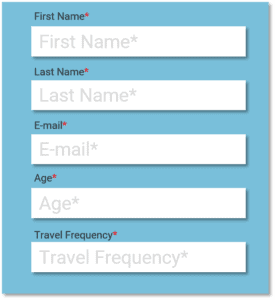Airline marketing executives have finally come around to the idea that yes, big data is important for them, too. But now, they are growing increasingly frustrated to find that their willingness to change is being rewarded with a lack of clarity about what to do next. Too often, this leads them to hire a “data expert” who has tons of e-Commerce experience – none of which helps with understanding the unique challenges and needs of the airline industry. Two different – but not mutually exclusive – ways to leverage all of this data have emerged: personalization and user search data.
Personalization: One Piece of the Puzzle
Almost universally, this approach takes the form of data “personalization”. This technique mostly works by building a demographic profile of customers on a site. This means recording things like the age, sex, nationality, and even income level behind every purchase. Over time, the results are aggregated, establishing a pattern of shopping habits for the site’s users.
From there, the patterns are used to create what are known as “look-alike audiences”. In its simplest form, the idea is that if a 16 year-old male purchases a baseball bat you have a better than average chance of selling them a baseball glove, too. You can then use aggregated profiles to predict behavior and personalize offers for other 16 year-old males.
User Search Data Fills in the Gaps
But there is a problem transferring this logic over to the airline industry: data personalization actually ignores the most prescient pieces of data regarding customer intent that airlines receive from their websites.
Simply put, a seventy-five year old Floridian snowbird and a student at the University of Florida may not have a single thing in common other than the fact that they are both searching for a round-trip ticket from New York to Orlando. Therefore, any conclusions drawn from aggregating these purchases for the purposes of cross-selling are going to be, let’s say, dubious at best.
User search data on the other hand, works differently. It looks at what people are searching for in real time, and draws fact-based conclusions from that. So when both a senior citizen and a college student are looking for a NYC-MCO flight, an airline’s system will recognize an intent to travel between those destinations, and offer deals accordingly.
Example of User Search Data that can be sourced from a Search Engine
Less Invasive & More Effective
There is another key difference between personalization and user search data techniques that needs to be mentioned. Because personalization relies on the construction of demographic profiles, it’s also reliant on receiving information from customers. This requires an airline to ask for it, a process which is fraught with difficulties in terms of accuracy and increased customer friction.
User search data techniques have no such liabilities or limitations. All that is required is to know what people are searching for and you are ready to serve them with targeted advertising or a relevant customer experience.
In fact, given how simple and effective the process is, the real wonder is why there are so many airline marketing executives who are trusting so called “data experts” who don’t recommend using user search data in the first place.
*****
Contact us here, if you need help harnessing all of that data.

